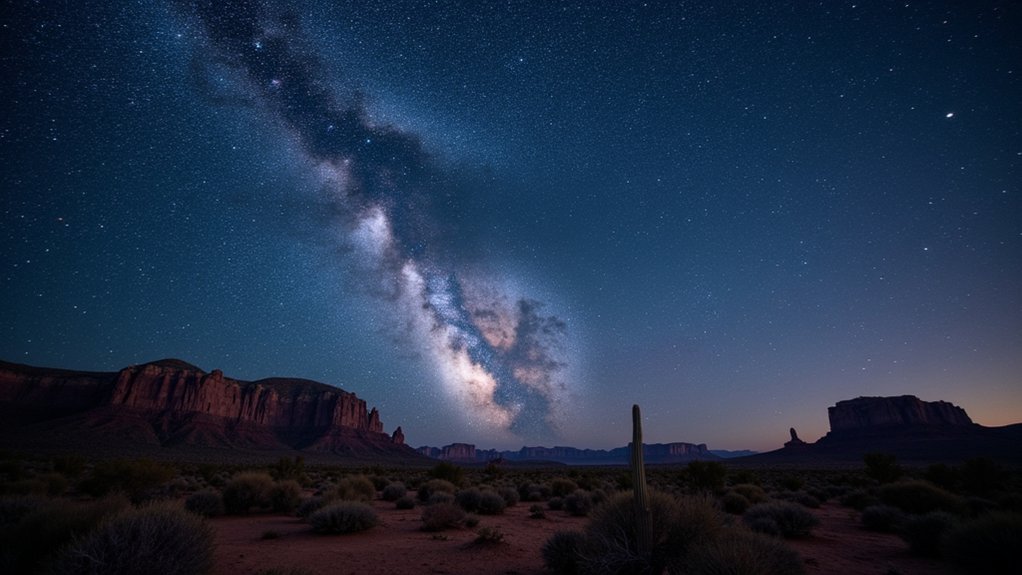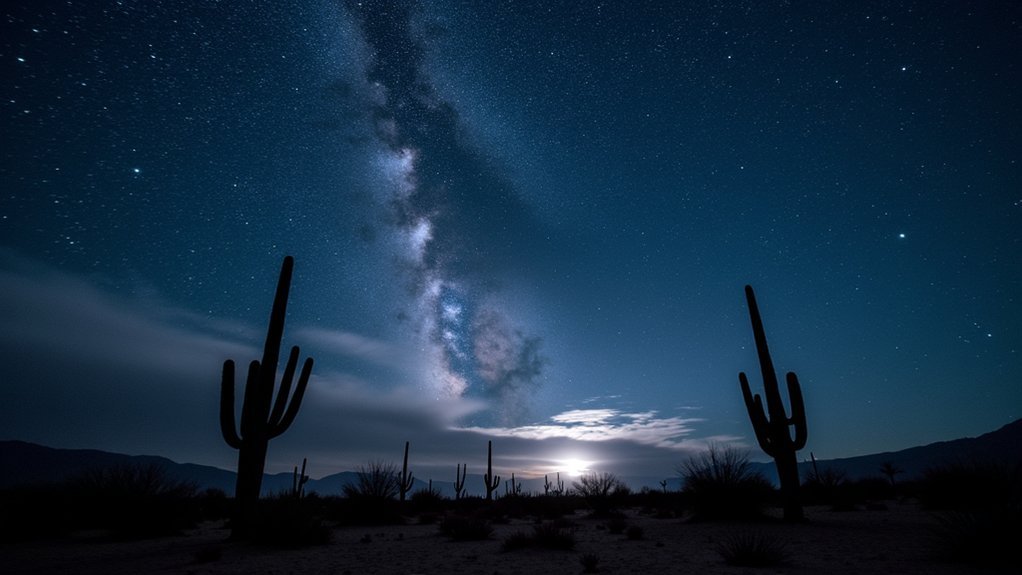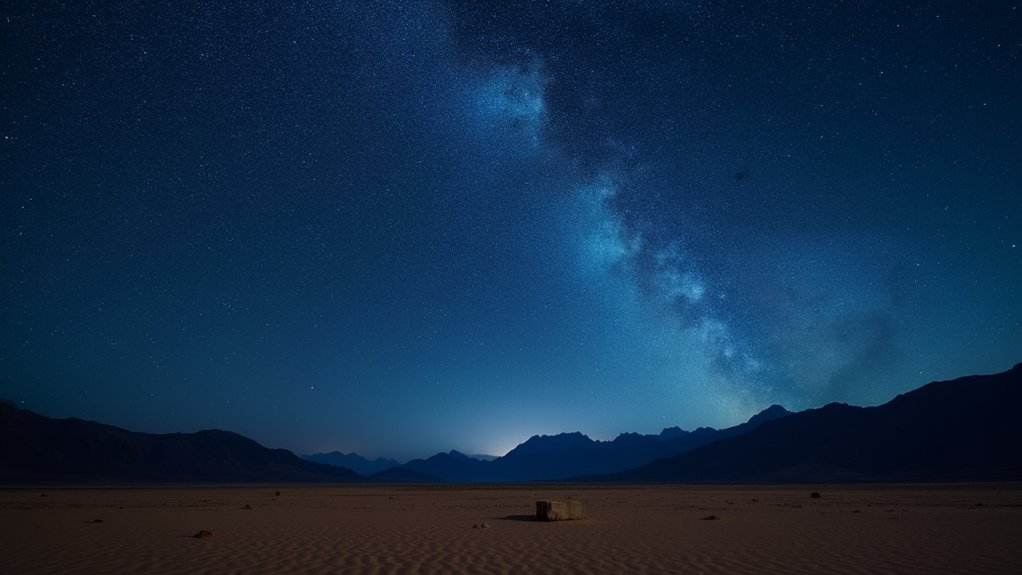Desert skies offer ideal conditions for astrophotography with minimal light pollution, low humidity, and consistently clear viewing opportunities. You’ll capture sharper celestial details thanks to the arid climate and stable air after sunset that reduces atmospheric distortion. The elevated terrain in many desert regions further enhances visibility by placing you above pollution layers. Desert landforms like sand dunes, rock arches, and cacti create stunning foreground elements that transform your night sky photos from simple star shots to compelling visual stories.
6 Second-Level Headings for “Why Desert Skies Create Perfect Astrophotography Shots”

When planning your astrophotography expedition, desert environments offer unparalleled advantages for capturing the cosmos.
You’ll find deserts provide the perfect dark sky conditions, virtually free from light pollution that plagues urban areas. This darkness allows for stunning long exposures that reveal celestial details invisible to the naked eye.
The arid desert climate minimizes humidity, creating exceptional atmospheric clarity that produces sharper, more detailed images of stars, galaxies, and nebulae.
Most desert regions also benefit from consistently clear sky conditions and minimal cloud cover, giving you more reliable shooting opportunities.
Higher elevation desert locations further enhance your astrophotography by reducing atmospheric interference.
As temperatures drop dramatically after sunset, the stable air results in less turbulence, allowing your camera to capture the cosmos with remarkable precision and vivid detail.
Finding Dark Sky Sanctuaries in Desert Regions
When searching for perfect astrophotography conditions, you’ll find unmatched opportunities in designated Desert Dark Sky Destinations where light pollution buffer zones protect the pristine night canvas.
These sanctuaries often provide strategically positioned observation points that maximize your distance from urban light domes while offering convenient access for photographers with equipment.
Higher elevation desert locations will greatly enhance your visibility of celestial objects, as you’ll be shooting through less atmosphere and encountering fewer atmospheric disturbances.
Desert Dark Sky Destinations
For astrophotographers seeking pristine celestial views, desert regions offer some of the world’s most exceptional dark sky sanctuaries.
San Pedro de Atacama in Chile provides Bortle 1+ skies at an elevation of 7,900 feet, where atmospheric interference is minimal and deep-sky objects shine brilliantly.
If you’re near San Diego, the Anza-Borrego Desert presents a convenient escape from light pollution.
This accessible desert delivers stunning Milky Way visibility without requiring extensive travel.
The characteristically low humidity of desert environments reduces atmospheric scattering, allowing your camera to capture crisp, detailed images of celestial objects.
Before your trip, consult light pollution maps to identify ideal shooting locations.
These resources help you pinpoint areas where urban illumination won’t interfere with your astrophotography, ensuring you’ll return home with breathtaking shots of the cosmos.
Light Pollution Buffer Zones
While light pollution maps help identify dark locations, understanding buffer zones around these sanctuaries dramatically improves your astrophotography planning.
Desert regions provide natural buffers against urban light domes, often extending 50-100 miles beyond city limits where Bortle scale ratings drop to ideal 1-2 levels.
You’ll find these buffer zones function differently across seasonal variations. Spring and fall typically offer cleaner atmospheric conditions, enhancing visibility even in shifting areas between light-polluted and pristine dark sky territories.
When scouting locations, look for elevated desert areas within these buffers—higher altitudes compound the isolation effect, providing clearer night skies.
For best astrophotography results, position yourself deep within these desert buffer zones rather than at their edges, ensuring maximum protection from scattered light pollution that can compromise your celestial captures.
Elevation Enhances Visibility
The marriage of elevation and desert terrain creates perfect conditions for stellar astrophotography opportunities. When you shoot at higher elevations like the Anza-Borrego Desert’s 4,300 feet, you’ll capture clearer images due to reduced atmospheric distortion and less light pollution interference.
| Elevation Feature | Visibility Benefit | Astrophotography Impact |
|---|---|---|
| Higher altitude | Less air pollution | Sharper star details |
| Desert positioning | Bortle 1-3 ratings | Vibrant Milky Way capture |
| Seasonal dryness | Minimal humidity | Reduced atmospheric blur |
| Distance from cities | Darker desert skies | Deeper celestial contrast |
Desert skies provide the perfect combination of elevation advantages and minimal light pollution. You’ll notice markedly improved image quality when shooting in these sanctuaries, as your camera can detect fainter celestial objects through the thinner, cleaner air above desert regions.
Essential Equipment for Desert Astrophotography Expeditions
Venturing into desert landscapes for astrophotography demands specialized gear that can withstand harsh conditions while capturing the celestial wonders above.
You’ll need a camera like the Canon 5D Mark iii that performs reliably in extreme temperatures for those long exposures under perfectly dark skies.
- Pair your camera with sturdy lenses such as the Canon 50mm 1.4 or Rokinon 14mm 2.8 for crisp celestial detail.
- Secure a robust tripod that you can weigh down with rocks to prevent movement in desert winds.
- Use protective covers like Telegizmo 365 to shield equipment from dust and temperature fluctuations.
- Apply narrowband filters (7/6.5nm Ha/Oiii & Sii) to cut through desert haze.
- Consider cooled cameras like QHY models to maintain ideal -10°C to -20°C operating temperatures.
Navigating Weather Patterns and Seasonal Conditions

Successfully capturing the cosmos requires understanding desert weather patterns that can either enhance or hinder your astrophotography efforts. The desert’s characteristically low humidity creates exceptional clarity for night sky imaging, with fewer atmospheric disturbances to obstruct your view.
You’ll find ideal shooting conditions during seasonal patterns shifting into spring and fall, when clear skies prevail and dust storms are less frequent. While these storms occasionally force you indoors, they eventually settle, leaving pristine conditions for your astrophotography sessions.
Consider timing your expeditions to higher elevations within desert regions, where you’ll benefit from reduced light pollution and cleaner air.
Elevation is the astrophotographer’s ally, offering pristine skies above desert plateaus where stellar clarity awaits.
Despite extreme temperature fluctuations, deserts like the Mojave offer spectacular visibility of celestial objects, particularly after daytime heat dissipates into cool, crisp evenings perfect for imaging the stars.
Mitigating Dust and Wind Challenges for Camera Protection
Two persistent enemies threaten your astrophotography equipment in desert environments: relentless dust and unpredictable winds. Protecting your imaging gear requires proactive measures to maintain optical clarity and mechanical integrity.
- Use Telegizmo 365 covers for their reflective properties and superior protection against harsh desert conditions.
- Clean lenses frequently with canned air or a bulb blower to prevent dust accumulation that degrades image quality.
- Move equipment indoors immediately when major dust storms approach to avoid permanent damage.
- Implement wind mitigation strategies like tarps or stabilized mounts when desert gusts exceed 30 mph.
- Choose refractors with sealed filter wheels for additional protection in sandy environments.
Don’t underestimate these environmental challenges—your equipment’s longevity and image quality depend on consistent protection from these harsh elements.
Desert Landforms as Compelling Foreground Elements

While protecting your equipment from desert hazards is necessary, the landforms surrounding you present remarkable artistic opportunities. Desert landforms create stunning foreground elements that transform ordinary star photos into extraordinary compositions. You’ll find the contrast between illuminated rock formations and the dark, star-filled sky creates natural drama in your images.
| Landform Type | Astrophotography Benefit |
|---|---|
| Sand dunes | Smooth curves guide eyes upward to stars |
| Rock arches | Natural frames for Milky Way or moon |
| Cacti | Silhouettes create iconic desert imagery |
| Mesas | Horizontal elements balance vertical startrails |
| Dry lakebeds | Reflective surfaces double celestial objects |
The exceptional clarity of desert air guarantees both your foreground elements and celestial objects remain crisp and detailed. Position yourself to use these geological features strategically, allowing their unique textures and shapes to complement your astrophotography.
Frequently Asked Questions
Why Can You See More Stars in the Desert?
You’ll see more stars in deserts because they have low humidity, minimal light pollution, and clear air. These conditions reduce atmospheric interference and brightness, allowing your eyes to detect fainter celestial objects more easily.
What Is the 400 Rule in Astrophotography?
The 400 rule helps you determine maximum exposure time without star trails. You’ll divide 400 by your lens focal length (in mm). For a 20mm lens, you’d get 20 seconds of exposure time.
What Makes a Good Astrophotography?
Good astrophotography requires dark skies with minimal light pollution, proper equipment setup, appropriate camera settings (wide aperture, low ISO), stable tripods, manual focusing, and timing your shots during new moons for maximum darkness.
What Time of Day Is Best for Astrophotography?
The best time for astrophotography is after sunset until dawn, particularly between 1-4 AM when the sky is darkest. You’ll get ideal results during new moons and astronomical twilight when stars appear brightest.
In Summary
When you’ve captured your desert astrophotography shots, you’ll appreciate why these arid landscapes offer the ultimate stargazing canvas. You’re now equipped to seek out dark sky locations, handle climate challenges, and incorporate stunning desert terrain into your compositions. Don’t hesitate to venture into these remote havens—your patience will be rewarded with breathtaking cosmic imagery that simply isn’t possible elsewhere.





Leave a Reply